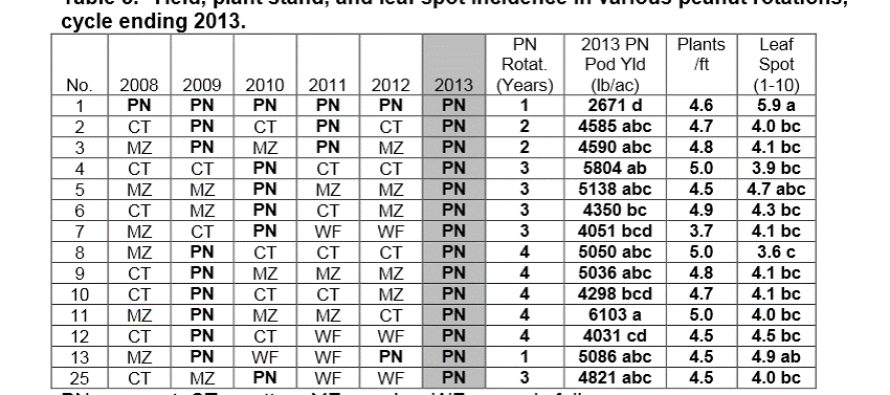Rotation Considerations for Peanut

I have been surveying growers, extension folks, consultants, and industry personnel over the last few weeks and it seems that the consensus is that we are going to significantly increase peanut acreage in the 2015 growing season. I think the increase will be a combination of current growers increasing their 2014 acreage numbers, growers who have been out since the boom in 2012 jumping back in, and new growers who are realizing that peanuts look pretty good when compared to most other options in our current economic climate. While I’m personally excited to see the acreage increase, there are some things we need to keep in mind going into this season.
One of these issues, especially important to those who have grown peanuts over the last few years, is that of rotation. Dr. Scott Tubbs, of the University of Georgia, recently published some new information in the 2015 UGA Peanut Update publication, based on field trials that I was fortunate enough to get to work on when I was in Tifton. In these trials, Dr. Tubbs grew peanuts in multiple rotation lengths, ranging from continuous peanut to four-year rotations. Specific rotation practices and results from those practices can be seen below.
I have posted a simplified yield comparison below, but I do want to point out a couple of things from above. First, for the 2013 results (Table 3), note leaf spot ratings using the Florida 1-10 scale. Even a single year out of peanut significantly reduced leaf spot pressure in nearly all cases. In the past, I might not have considered that a huge deal for us. However, considering the ubiquity of the leaf spot diseases here in Mississippi during the 2014 season, it is something we really need to pay attention to going forward when considering rotation practices. It’s here to stay now and is something we are going to have to deal with. Table 4 lists the results from a continuation of that trial in 2014. Again, note the far right column. While we don’t (yet) deal with peanut root-knot nematode here in the state, I want to make two points. First, based on my colleague Alan Henn’s research into historical peanut production, we know that this root-knot nematode species is in the state somewhere and is something we will likely deal with in the future. Second, and probably more importantly right now, I think it speaks to the effectiveness of rotations at reducing nematode numbers in general. A simple one year out of peanut cut nematode numbers by an average of 56%. Two years out of peanut cut numbers by an average of 79%, while three years out or peanut resulted in a 96% reduction.
As you can see above, a simple two-year rotation (one year out of peanut) increased yield by an average of 1,872 lb/acre. A three year rotation (two years out of peanut) increased yield by 2,332 lb/acre, while a four year rotation (three years out of peanut) increased yield by 2,348 lb/acre. A three year rotation proved to be optimal as far as yields were concerned and I think results would look similar for us in Mississippi. I do have a long-term rotation test underway here in the state, so I look forward to sharing those numbers as they come in.







Let me tell You a sad story ! There are no comments yet, but You can be first one to comment this article.
Write a comment